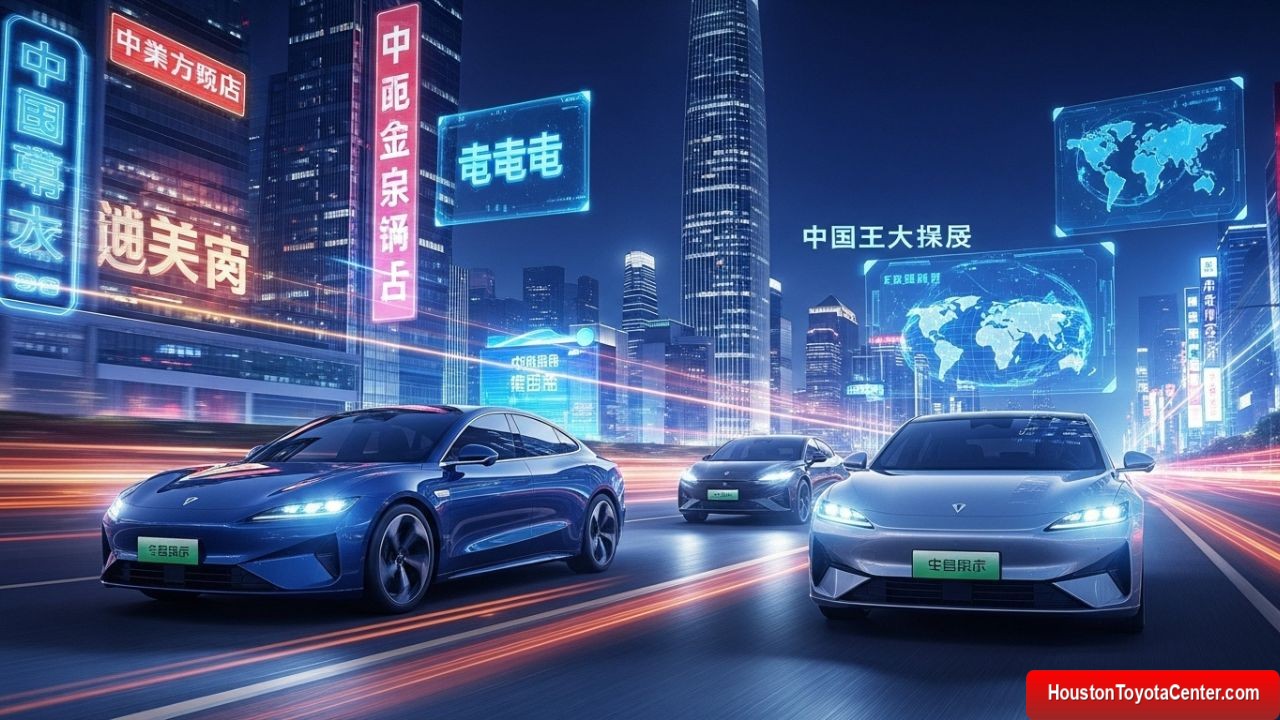In the past two decades, the automotive landscape has witnessed a profound transformation. What was once dominated by American, European, and Japanese giants is now being reshaped by the rapid ascent of Chinese automakers. Once criticized for low-quality, cheap imitation cars, brands from China have matured — now standing as formidable global competitors with cutting-edge designs, strong technology integration, and bold international expansion plans.
This shift didn’t happen overnight. It is the result of strategic government support, vast domestic demand, aggressive innovation, and an evolving global perception of what “Made in China” means. Today, Chinese automakers are not only producing vehicles that rival the likes of Toyota, Tesla, and Volkswagen but are also redefining the future of electric mobility and automotive technology worldwide.
1. From Copycats to Innovators: A Short Historical Overview
In the early 2000s, Chinese automakers like Chery, Geely, and BYD were primarily focused on producing affordable cars for domestic consumers. These vehicles were often inspired—sometimes too closely—by designs from established international brands. Quality control, safety standards, and design originality were major criticisms.
But as China’s economy boomed and middle-class income surged, consumer expectations also evolved. Domestic buyers started demanding more than just affordability — they wanted reliability, performance, and sophistication. This forced local manufacturers to shift their priorities, investing heavily in research and development.
FREE: Quickly identify and understand problems with your vehicle 🚘
CLICK HEREFast forward to the 2020s, and companies like BYD, NIO, XPeng, and Geely are not only competing domestically but also exporting high-quality vehicles to Europe, the Middle East, and South America. The “cheap imitator” stigma is fading fast, replaced by the image of a tech-driven industry leader.
2. The Role of the Chinese Government in Automotive Growth
One of the most significant factors behind the rise of Chinese automakers is state support. The Chinese government identified the automotive industry as a pillar of national growth, creating policies that favored domestic innovation and technological independence.
Key initiatives included:
| Policy/Program | Objective | Impact |
|---|---|---|
| Made in China 2025 | To advance high-tech manufacturing sectors including automotive and EVs | Boosted R&D investment and localization of key components |
| NEV (New Energy Vehicle) Mandate | To accelerate EV production and reduce emissions | Made China the world’s largest EV market |
| Export Incentives | To encourage automakers to enter global markets | Increased brand visibility abroad |
| Battery Supply Chain Strategy | To control the full EV ecosystem | Created dominant battery producers like CATL |
These policies transformed China from a car assembly hub to a leader in EV innovation, giving local brands an edge over many Western competitors who were slower to adapt to the electrification wave.
3. The Electric Vehicle Revolution: China Takes the Lead
If there is one segment where China has truly taken the global lead, it’s electric vehicles (EVs). The country now produces and consumes more EVs than any other nation in the world.
BYD: The Global Benchmark
BYD, short for “Build Your Dreams,” has become the face of China’s EV revolution. Originally a battery manufacturer, BYD leveraged its expertise to dominate EV production. Its lineup, ranging from affordable urban EVs to luxury electric sedans like the BYD Han, showcases impressive engineering and efficiency.
In 2023, BYD even surpassed Tesla in global EV sales, signaling a monumental shift in market dynamics.
NIO and XPeng: The Premium Tech Players
Brands like NIO and XPeng are redefining what premium EV experiences mean. NIO’s battery-swapping stations and autonomous driving systems offer futuristic mobility solutions, while XPeng’s AI-powered driving assistance rivals the technology found in Western luxury vehicles.
SAIC and Geely: Scaling the Legacy
Older companies like SAIC Motor and Geely have modernized their operations and partnered with global brands like General Motors and Volvo. These collaborations helped Chinese automakers learn international best practices while developing their own global brands.
4. Breaking into Global Markets
Chinese automakers are no longer content with domestic dominance. Their eyes are firmly set on global expansion.
Europe: A Crucial Testing Ground
Europe, with its stringent emissions regulations and high consumer standards, is the ultimate proving ground for automakers. Chinese EVs like the MG4 (owned by SAIC) and BYD Atto 3 have received strong reviews for build quality, performance, and affordability.
The success of these vehicles in markets like Germany, the UK, and Norway demonstrates that Chinese brands can meet — and sometimes exceed — Western quality standards.
Emerging Markets: Rapid Growth
In regions like Southeast Asia, Latin America, and Africa, Chinese automakers are rapidly gaining market share due to their competitive pricing, reliable technology, and flexible financing options. Local governments often favor Chinese partnerships because of affordable infrastructure investments tied to vehicle imports.
5. Technology and Innovation as Core Strengths
The new wave of Chinese vehicles stands out not just because of cost advantages but because of technological innovation.
a. Software-Defined Vehicles
Chinese brands are leading the transition to software-first cars — vehicles that improve over time through over-the-air updates (OTA).
b. Artificial Intelligence Integration
From voice-controlled assistants to autonomous driving systems, AI is at the heart of Chinese car innovation. For example, XPeng’s City NGP (Navigation Guided Pilot) system offers high-precision automated driving rivaling Tesla’s FSD.
c. Battery Technology
China dominates battery production, controlling over 70% of the global EV battery market. Companies like CATL and BYD produce high-density, long-life batteries that power not only Chinese cars but also vehicles from BMW, Tesla, and Ford.
d. Smart Cockpits
Modern Chinese cars feature large digital dashboards, AR heads-up displays, and seamless smartphone integration, creating a highly digital, user-centered experience.
6. The Quality Transformation: Perception vs. Reality
One of the biggest challenges for Chinese automakers abroad is changing consumer perception. For years, “Chinese cars” were associated with low-quality and poor safety ratings. However, this is rapidly changing.
Safety and Reliability
Many Chinese models now achieve 5-star safety ratings in European NCAP tests, a remarkable improvement from a decade ago.
Build Quality
The fit-and-finish of interiors in cars like the BYD Seal or NIO ET7 can rival German luxury vehicles, featuring premium materials, advanced noise insulation, and precision assembly.
Durability Testing
Chinese automakers have established world-class testing centers for cold weather, desert, and urban environments, ensuring vehicles meet global durability expectations.
7. Global Partnerships and Acquisitions
Strategic collaborations have played a huge role in the global recognition of Chinese automakers.
- Geely’s acquisition of Volvo (2010) gave it access to premium engineering and safety technology.
- SAIC’s partnership with GM strengthened its global distribution network.
- BYD’s collaboration with Toyota on battery and EV technology expanded its innovation footprint.
These alliances have turned Chinese manufacturers into global powerhouses capable of competing with the world’s best.
8. Challenges on the Road Ahead
Despite their impressive progress, Chinese automakers face several challenges in their quest for global dominance.
| Challenge | Description | Potential Solution |
|---|---|---|
| Brand Perception | Some consumers still distrust Chinese-made products | Marketing campaigns emphasizing safety, design, and innovation |
| Trade Barriers | Tariffs and political tensions, especially with the U.S. | Local assembly plants and joint ventures |
| Supply Chain Complexity | Overreliance on domestic production | Diversifying production across Asia and Europe |
| Competition | Established brands accelerating EV transition | Continuous innovation and pricing strategy |
Still, with a combination of government support, global partnerships, and relentless innovation, Chinese brands seem ready to overcome these hurdles.
9. How Western Automakers Are Reacting
The rise of Chinese automakers has put pressure on legacy brands. Companies like Volkswagen, Ford, and Toyota are now racing to accelerate their EV roadmaps, while also reevaluating pricing and technology strategies.
Some Western automakers have chosen to collaborate rather than compete head-on. For example, BMW and Mercedes-Benz source batteries from Chinese suppliers, while Volkswagen invested billions in Chinese EV startups.
10. The Road to the Future: China’s Vision for Global Mobility
Chinese automakers aren’t just making cars — they’re building ecosystems of mobility. From electric scooters to self-driving taxis and connected smart cities, their goal is to create a seamless network of sustainable transportation.
Key futuristic projects include:
- Robo-taxis operated by Baidu’s Apollo.
- Smart traffic systems integrated with 5G.
- Vehicle-to-grid (V2G) energy sharing for renewable power grids.
This vision aligns with China’s broader national goals of carbon neutrality by 2060 and technological independence.
11. The Verdict: China Is Driving the Future
The rise of Chinese automakers is not a temporary trend — it’s a paradigm shift. What once began as a race to catch up has turned into a race to lead.
Today, the world watches as Chinese brands challenge the old order, forcing even the most established automakers to rethink their strategies. With relentless innovation, growing international credibility, and unmatched control over EV infrastructure, China is steering the future of global mobility.
Key Takeaways
| Aspect | Then | Now |
|---|---|---|
| Reputation | Low quality, imitation-based | High-tech, innovative |
| Market Focus | Domestic | Global |
| Technology | Dependent on foreign R&D | Self-sufficient and leading |
| EV Leadership | Emerging | Dominant |
| Global Presence | Minimal | Expanding rapidly |
Final Thoughts
In the same way that Japan rose in the 1970s and Korea in the 1990s, China’s automotive revolution of the 2020s will be remembered as the decade when global mobility changed forever.
With sustainability, smart technology, and innovation at its core, the world should no longer underestimate Chinese automakers. They have arrived — and they are here to stay.


Leave a Reply